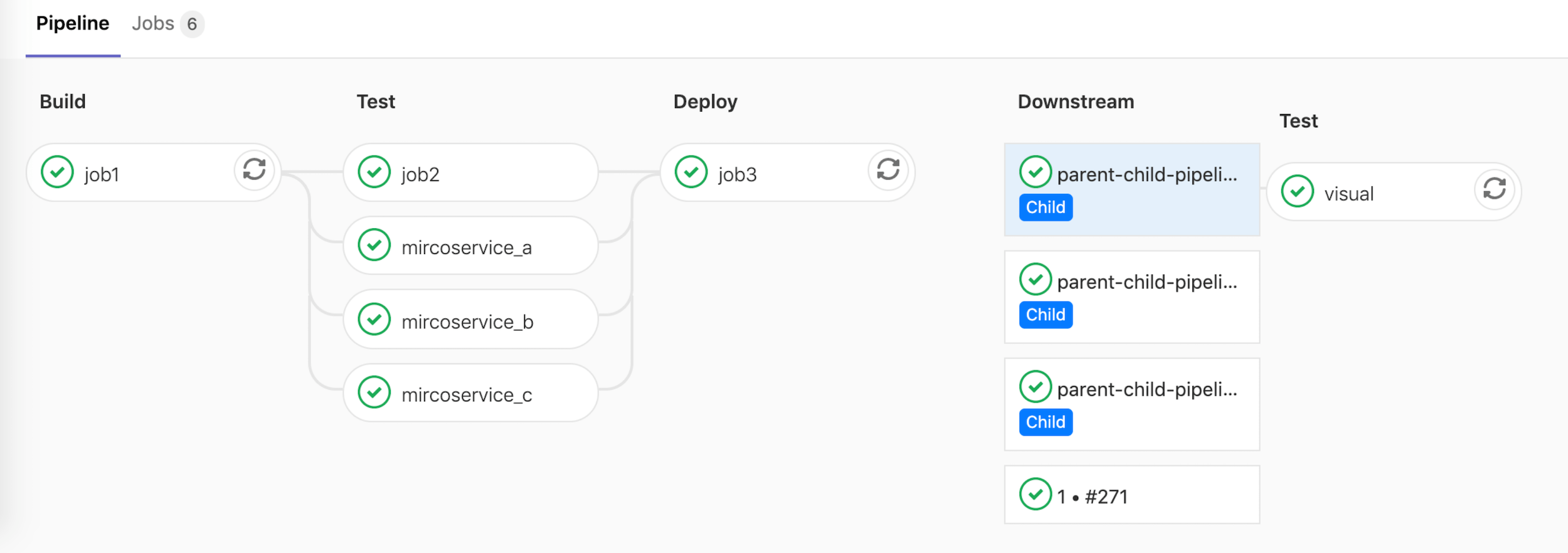Parent-child pipelines
Introduced in GitLab 12.7.
As pipelines grow more complex, a few related problems start to emerge:
- The staged structure, where all steps in a stage must be completed before the first job in next stage begins, causes arbitrary waits, slowing things down.
- Configuration for the single global pipeline becomes very long and complicated, making it hard to manage.
- Imports with
includeincrease the complexity of the configuration, and create the potential for namespace collisions where jobs are unintentionally duplicated. - Pipeline UX can become unwieldy with so many jobs and stages to work with.
Additionally, sometimes the behavior of a pipeline needs to be more dynamic. The ability to choose to start sub-pipelines (or not) is a powerful ability, especially if the YAML is dynamically generated.
Similarly to multi-project pipelines, a pipeline can trigger a set of concurrently running child pipelines, but within the same project:
- Child pipelines still execute each of their jobs according to a stage sequence, but would be free to continue forward through their stages without waiting for unrelated jobs in the parent pipeline to finish.
- The configuration is split up into smaller child pipeline configurations, which are easier to understand. This reduces the cognitive load to understand the overall configuration.
- Imports are done at the child pipeline level, reducing the likelihood of collisions.
- Each pipeline has only relevant steps, making it easier to understand what's going on.
Child pipelines work well with other GitLab CI/CD features:
- Use
only: changesto trigger pipelines only when certain files change. This is useful for monorepos, for example. - Since the parent pipeline in
.gitlab-ci.ymland the child pipeline run as normal pipelines, they can have their own behaviors and sequencing in relation to triggers.
See the trigger: keyword documentation for full details on how to
include the child pipeline configuration.
For an overview, see Parent-Child Pipelines feature demo.
Examples
The simplest case is triggering a child pipeline using a local YAML file to define the pipeline configuration. In this case, the parent pipeline will trigger the child pipeline, and continue without waiting:
microservice_a:
trigger:
include: path/to/microservice_a.ymlYou can include multiple files when composing a child pipeline:
microservice_a:
trigger:
include:
- local: path/to/microservice_a.yml
- template: SAST.gitlab-ci.ymlNOTE: Note:
The max number of entries that are accepted for trigger:include: is three.
Similar to multi-project pipelines, we can set the parent pipeline to depend on the status of the child pipeline upon completion:
microservice_a:
trigger:
include:
- local: path/to/microservice_a.yml
- template: SAST.gitlab-ci.yml
strategy: dependMerge Request child pipelines
To trigger a child pipeline as a Merge Request Pipeline we need to:
- Set the trigger job to run on merge requests:
# parent .gitlab-ci.yml
microservice_a:
trigger:
include: path/to/microservice_a.yml
rules:
- if: $CI_MERGE_REQUEST_ID-
Configure the child pipeline by either:
-
Setting all jobs in the child pipeline to evaluate in the context of a merge request:
# child path/to/microservice_a.yml workflow: rules: - if: $CI_MERGE_REQUEST_ID job1: script: ... job2: script: ... -
Alternatively, setting the rule per job. For example, to create only
job1in the context of merge request pipelines:# child path/to/microservice_a.yml job1: script: ... rules: - if: $CI_MERGE_REQUEST_ID job2: script: ...
-
Dynamic child pipelines
Introduced in GitLab 12.9.
Instead of running a child pipeline from a static YAML file, you can define a job that runs your own script to generate a YAML file, which is then used to trigger a child pipeline.
This technique can be very powerful in generating pipelines targeting content that changed or to build a matrix of targets and architectures.
For an overview, see Create child pipelines using dynamically generated configurations.
We also have an example project using Dynamic Child Pipelines with Jsonnet which shows how to use a data templating language to generate your .gitlab-ci.yml at runtime. You could use a similar process for other templating languages like Dhall or ytt.
In GitLab 12.9, the child pipeline could fail to be created in certain cases, causing the parent pipeline to fail. This is resolved in GitLab 12.10.
Nested child pipelines
- Introduced in GitLab 13.4.
- It's deployed behind a feature flag, enabled by default.
- It's enabled on GitLab.com.
- It's recommended for production use.
- For GitLab self-managed instances, GitLab administrators can opt to disable it. (CORE ONLY)
Parent and child pipelines were introduced with a maximum depth of one level of child pipelines, which was later increased to two. A parent pipeline can trigger many child pipelines, and these child pipelines can trigger their own child pipelines. It's not possible to trigger another level of child pipelines.
Enable or disable nested child pipelines (CORE ONLY)
Nested child pipelines with a depth of two are under development but ready for production use. This feature is deployed behind a feature flag that is enabled by default.
GitLab administrators with access to the GitLab Rails console can opt to disable it.
To enable it:
Feature.enable(:ci_child_of_child_pipeline)To disable it:
Feature.disable(:ci_child_of_child_pipeline)